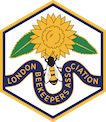
|
London Beekeepers' Association |

|
London Beekeepers' Association |
What's in Flower in MarchPrimrose Winter aconite Wild damson Buff tailed queen on crocus Honey bee on crocus Buff tailed queen on winter heather [What's in flower, month by month] Mark Patterson March is officially the first month of spring for us in the UK, but it's pretty wet and cold recently. The first of the spring flowers are already putting on a colourful show of yellows, purples and shades of white. Snowdrops are starting to pass their best, having flowered in large numbers since late January. The early flowering crocus species are currently looking at their best across most of London. The later flowering large flowered crocus varieties are just starting to join the display too. These and other spring bulbous plants include Winter Aconite, Anenemone blanda, Squill and Muscari. These are valuable early sources of pollen for bees. Garden plants important to bees this month include the Hellebores (the hybrid Hellebores in my garden are particularly popular with bees at the moment), Pulmonaria and Wallflowers. Both the biennial bedding wallflowers and short lived perennial varieties are attractive to bees, but it's the Everlasting Wallflower Bowles Mauve that is flowering best at present; the others will put on a fantastic show towards the end of March and into April. Several Spring flowering trees are important to bees and these include White Poplar, Willow, and Hazel. The large Hazel tree in my apiary has been flowering since January but is at its peak now. The willow and white beam catkins are just starting to open. One of the best small willows for gardens is Salix caprea Kilmarnock which is a pussy willow type with large fluffy catkins which become covered in bright lemon yellow pollen. All manner of bees adore it. Last spring whilst cycling through Archbishops Park en route to the LBKA monthly meeting, I passed a trio of these dwarf weeping trees which were covered in honey bees, Ashy Mining bees, Painted Mining bees and several bumblebees. These trees all have pollen with a high protein and fatty acids content valuable to bees rearing brood and for queens fattening up ready to begin laying. Shrubs flowering this month attractive to bees include flowering currant, Sarcoccoca, blackthorn, flowering quince and camelia. At last month's RHS early Spring Flower Show I bought 2 new camelias for my garden, a light pink one and a dark pinkie red one called ``Adeyaka''. Both are open single flowered varieties which flower from Late February through to Early May and are ``self cleaning'' varieties which mean the blooms drop as soon as they are pollinated, or if the blooms become frosted resulting in a neat looking shrub without the tainted frost damaged petals which can look unsightly. Other flowers making an appearance include lesser celandine, sweet violet, cowslip, primrose, white deadnettle, bugle, ground ivy and the first of the Spanish bluebells (Hyacinthoides Hispanica) whose blue-green pollen Honey bees will collect. white deadnettle in particular is a valuable wild plant for bumble bees and some of the longer-tongued solitary bees. Its pollen is rich in protein and fats. Jobs in the gardenThis time of year presents us with the last opportunity to lift and divide herbaceous perennials before they start to put on significant growth. I've just lifted and split my Helleniums, hardy geraniums, Japanese anemones and sedum spectable. Plant out herbaceous perennials that were grown from seed or cuttings last year. Get them in the ground now so they have time to spread out their roots ahead of the coming growing season. Less hardy plants may still require protection with fleece. Have fleece available to protect the blooms of soft fruits. My peach and nectarine buds are starting to open -- will I get any fruit this year? Early March is the last opportunity to prune apples and pears. Stone fruits such as peach, plum and apricot should be pruned in late summer. When pruning apples and pear resist the urge to cut back too much growth which the trees respond to by putting on excess vigorous regrowth. Unlike plum and other stone fruits which flower on the previous year's wood, Pip fruits require 2 year old material to develop flower/fruit buds. |
©2025 London Beekeepers' Association |